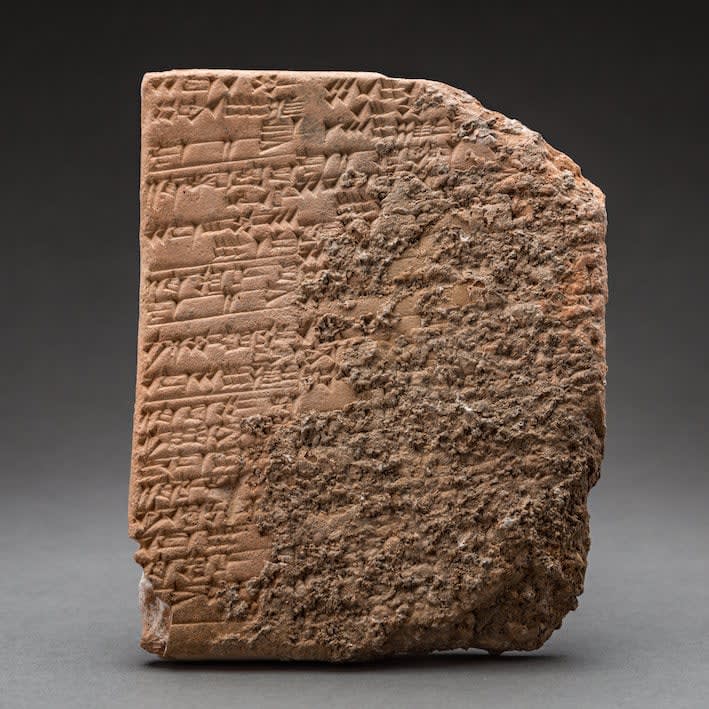Sumerian Cuneiform Tablet, 2030 BCE
Terracotta
4.5 x 5.75
LSO.1003
Further images
Sumerian cuneiform is one of the earliest known forms of written expression. First appearing in the 4th millennium BC in what is now Iraq, it was dubbed cuneiform (‘wedge-shaped’) because...
Sumerian cuneiform is one of the earliest known forms of written expression. First appearing in the 4th millennium BC in what is now Iraq, it was dubbed cuneiform (‘wedge-shaped’) because of the distinctive wedge form of the letters, created by pressing a reed stylus into wet clay. Early Sumerian writings were essentially pictograms, which became simplified in the early and mid 3rd millennium BC to a series of strokes, along with a commensurate reduction in the number of discrete signs used (from c.1500 to 600). The script system had a very long life, and was used by the Sumerians as well as numerous later groups – notably the Assyrians, Elamites, Akkadians and Hittites – for around three thousand years. Certain signs and phonetic standards live on in modern languages of the Middle and Far East, but the writing system is essentially extinct. It was therefore cause for great excitement when the ‘code’ of ancient cuneiform was cracked by a group of English, French and German Assyriologists and philologists in the mid 19th century AD. This opened up a vital source of information about these ancient groups that could not have been obtained in any other way. Cuneiform was used on monuments dedicated to heroic – and usually royal – individuals, but perhaps it’s most important function was that of record keeping. The palace-based society at Ur and other large urban centres was accompanied by a remarkably complex and multifaceted bureaucracy, which was run by professional administrators and a priestly class, all of whom were answerable to central court control. Most of what we know about the way the culture was run and administered comes from cuneiform tablets, which record the everyday running of the temple and palace complexes in minute detail, as in the present case. The Barakat Gallery has secured the services of Professor Lambert (University of Birmingham), a renowned expert in decipherment and translation of cuneiform, to examine and process the information on these tablets. His analysis is presented below.
Clay Tablet (147 x 115 mm) with Sumerian Cuneiform inscription. This is a large tablet with a total of six columns, three each side, and in fair condition. The corners of the left side are incomplete, and there is a little damage to the right hand edge, but generally the surface is preserved and covered with a large scribal hand. It is an administrative document from the period of the Third Dynasty of Ur, dated to the 9th year of the fourth king of the dynasty, Shi-Sin, that is c. 2029 BC. It is a record of barley produced in a given district, listing the various “fields” with their sizes and the quantity of barley produced in each, presumably during the preceding season.
Some of the surface is covered with salt encrustation acquired in the saline soil of southern Iraq, and this could be removed with laboratory treatment. The whole of the obverse and the first line on the reverse with the top of the second are devoted to listing each “field” in turn with details of size and quantities of grain produced. Then the remainder of column V and the top of column VI are devoted to summing up these dats, and the final paragraph in column VI, the end of the tablet, gives more explanation: “Long” field: barley winnowed with stick rations for ploughmen, herders, drivers of plough-oxen, 30 of them.
Abum-baqar is the official in charge,
via Adallal the scribe.
Year: Shu-Sin, king of Ur, built the templ of (the god) Shara in Umma. So the barley produced in these “fields” was meant to pay the wages of the various farm workers employed on this estate.
Clay Tablet (147 x 115 mm) with Sumerian Cuneiform inscription. This is a large tablet with a total of six columns, three each side, and in fair condition. The corners of the left side are incomplete, and there is a little damage to the right hand edge, but generally the surface is preserved and covered with a large scribal hand. It is an administrative document from the period of the Third Dynasty of Ur, dated to the 9th year of the fourth king of the dynasty, Shi-Sin, that is c. 2029 BC. It is a record of barley produced in a given district, listing the various “fields” with their sizes and the quantity of barley produced in each, presumably during the preceding season.
Some of the surface is covered with salt encrustation acquired in the saline soil of southern Iraq, and this could be removed with laboratory treatment. The whole of the obverse and the first line on the reverse with the top of the second are devoted to listing each “field” in turn with details of size and quantities of grain produced. Then the remainder of column V and the top of column VI are devoted to summing up these dats, and the final paragraph in column VI, the end of the tablet, gives more explanation: “Long” field: barley winnowed with stick rations for ploughmen, herders, drivers of plough-oxen, 30 of them.
Abum-baqar is the official in charge,
via Adallal the scribe.
Year: Shu-Sin, king of Ur, built the templ of (the god) Shara in Umma. So the barley produced in these “fields” was meant to pay the wages of the various farm workers employed on this estate.





